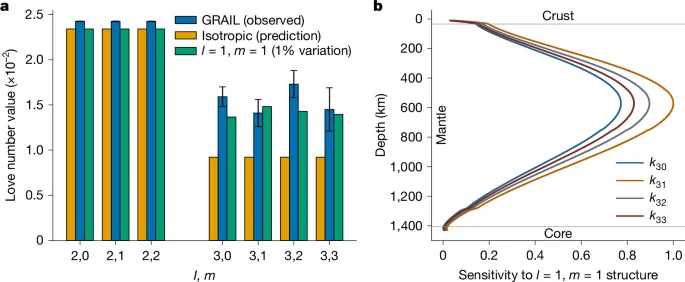
New NASA Studies Reveal Surprising Secrets Hidden Deep Within the Moon’s Interior
The moon, Earth's constant companion, has always held mysteries that have fascinated scientists and stargazers alike. Now, new NASA studies are shedding light on the hidden secrets of the moon's interior, revealing unexpected thermal asymmetries and challenging previous assumptions about its structure. Why does one side of the moon still glow from within? What insights do these discoveries offer about the formation of our celestial neighbor and other planetary bodies?

For decades, scientists have observed the striking differences between the moon's near side, characterized by smooth, dark plains, and its far side, which is rugged and heavily cratered. A key piece of this puzzle comes from NASA's GRAIL mission, which used two spacecraft, Ebb and Flow, to meticulously measure the moon's gravity. These measurements revealed a surprising temperature difference deep within the lunar mantle, offering a compelling explanation for the contrasting appearances of the two hemispheres.
Ryan Park, supervisor of the Solar System Dynamics Group at NASA’s Jet Propulsion Laboratory, led the groundbreaking research, published in the journal *Nature*. Park and his team focused on a parameter called the gravitational tidal Love number, k3, which reflects how the lunar mantle deforms under gravitational forces. "We report our estimated value of k3 = 0.0163 ± 0.0007, which is about 72% higher than that expected for a spherically symmetric moon," the researchers noted.

This discovery indicates that the moon's mantle isn't uniform. The near side is warmer, softer, and more flexible compared to the cooler, stiffer far side. The cause? Radioactive elements like thorium and uranium, trapped in ancient lava flows that blanketed the near side billions of years ago. These elements continue to release heat, keeping the nearside mantle significantly warmer – up to 170°C (338°F) hotter than the far side.
These findings also have implications for understanding lunar seismic activity. The warmer nearside mantle likely contains pockets of partially melted rock, which could act as stress points, triggering moonquakes when subjected to Earth's gravitational pull. These melt zones are located at depths of 800 to 1,250 km (497 to 777 miles), coinciding with the location of many deep moonquakes.
The thermal asymmetry also helps explain the moon's volcanic past. Billions of years ago, lava flowed across the surface, creating the dark spots we see on the nearside. As this lava cooled, it trapped radioactive elements, creating the thermal imbalance that persists today. The lack of such lava flows on the far side allowed it to cool more quickly, resulting in its rugged, cratered appearance.
Tidal tomography, the technique used by Park's team, involves analyzing subtle changes in the moon's gravity as it orbits Earth. By mapping these gravitational fluctuations, scientists can effectively create a detailed "X-ray" of the moon's internal structure. This technique isn't limited to the moon; it can be applied to other celestial bodies like Mars, Enceladus, and Ganymede, potentially revealing hidden structures and processes without the need for landers or probes.

Looking ahead, NASA's planned lunar missions, including the Farside Seismic Suite and the Lunar Geophysical Network, aim to monitor moonquakes and map the lunar mantle in even greater detail, potentially confirming the existence of melt zones and detecting ongoing volcanic activity.
The discovery of the moon's thermal asymmetry challenges our understanding of its geological evolution and opens up new avenues for exploring the interiors of other planetary bodies. Why is the nearside hotter? Could residual magma still be flowing beneath the surface? What does this mean for future moonquakes? The GRAIL mission has provided pieces of the moon's history, but many questions remain unanswered.
What are your thoughts on these fascinating lunar discoveries? Share your comments and insights below!